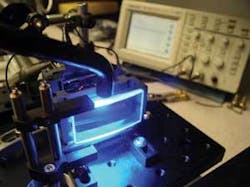System optimization/customization is key to success
A discussion with Paul Bourget, LumenFlow
Paul Bourget is president of LumenFlow Corp. (Middleville, MI, USA; www.lumenflow.com). He received his bachelor’s degree in physics from SUNY at Plattsburgh, NY. His 30-year career in optics began at Bausch & Lomb in 1976. He has worked as an optical, video, and project engineer in aerospace, metrology, and instrumentation, and he holds several patents in optical technology. Editor in chief Conard Holton spoke to him about optical design and product development.
VSD: Who are your customers and how do you serve them?
Bourget: LumenFlow designs and manufactures custom optical devices and sub-assemblies, lighting solutions, and laser modules for a variety of customers. We have clients across aerospace, telecom, medical, instrumentation, machine vision, night vision, and metrology business sectors. We serve our customers by providing whole system optimization. We design lenses but we also take a hard look at all the interrelated hardware, especially lighting and cameras. We will focus on assembly procedures, assembly fixtures, and testing fixtures and do project management to smooth out the wrinkles that can plague a new product launch. We are a product developer anywhere optics plays a key role.
VSD: Why do companies use your services? What expertise do you provide?
Bourget: Our team has extensive expertise in optical, electrical, mechanical, and manufacturing disciplines. We solve photonics problems that our clients have not been able to solve for themselves, always starting with the question “What do you want the light to do?” From there, we can provide a solution customized for the application.
We were contacted recently by a manufacturer of metrology instruments who couldn’t get consistent performance from a new product under development. We were able to determine the causes, design a total solution, and then implement the optical subsystems in an easily manufactured modular form.
Another client, whose noncontact IR measurement device used standard Nikon lenses, required a replacement when the Nikon products were discontinued. The new custom lenses displayed better IR performance and had a “drop in” fit that reduced assembly time.
And a machine-vision client, whose product used off-the-shelf lenses, found that our custom lenses improved performance without raising cost. The new custom lenses we developed and delivered allowed the instrument to see attributes that their algorithms hadn’t previously extracted from the images.
VSD:What sort of machine-vision systems have you developed, and what other types of systems do you design?
Bourget:We design and manufacture the front-end components and subsystems of machine vision-lighting, lensing, and camera interface. We believe that these three elements are key to making a machine-vision system perform at its best. You must create the correct light and place it on the object of interest. Then you must gather the necessary light from the object and create the proper image on your camera plane. The camera plane then transfers a digital image to your software for processing. If any part of that system is compromised, you are going to get lousy results since no amount of real-time software can correct for bad image quality. If you get the front-end optimized then you can reduce the workload on the software.
We also do a lot of metrology and instrumentation-systems work. We optimize the front end as a whole-which means developing custom lenses and illumination for UV, visible, near-IR, and thermal imaging applications where an off-the-shelf solution under-performs or does not exist.
VSD: What developments do you see in the area of structured laser light sources for machine-vision systems? How are optics companies meeting these needs?
Bourget:The need for high-quality laser line generators with energy distribution of either Gaussian or top-hat has grown. High quality means wide-angle projection without distortion, asymmetrical patterns, or unusual flares. There has been a demand for complex laser pattern targets, as well. We have a client that required a trapezoidal box pattern with a cross hair. The trick was to project the cross hair not in the geometrical center of the trapezoid but in the center of view from a particular lens perspective.
We have completed several projects that require the shaping of LED source light. One involved the generation of a bar of blue light ¼ in. thick and 3 ft long projected against an orange background field used for grain sorting. The important point to remember is that any successful machine-vision system starts out with the right lighting. By that I mean the right wavelength (narrow or broadband), correct intensity, best contrast ratio, accurate placement, and correct aiming. This being the first step, then the second step is to eliminate any unwanted light or signal from the field of view. Now you are making the light work for you.
More optical companies are looking at supplying non-conventional optics-diffractive and holographic elements that make the light do a specific function. The upfront engineering cost may be higher but the improvement of functionality can justify this especially when amortized over many systems.
LumenFlow customized laser transmitter module is installed into a state-of-the-art metrology instrument.
VSD: What standards developments are required to allow OEMs to offer these products in a standard format?
Bourget:The newer generation of CCD chips are getting larger, and that means C-mount-based optics aren’t going to work and, in some applications, an F-mount is going to compromise the outer edge of the image. The problem is the machine-vision industry is holding onto an older photographic standard that doesn’t really fit the new industry’s needs. Only in the last seven years or so have we seen a commonality of needs arise from real production.
Almost every metrology and machine-vision application requires that the iris (system stop) be set once and the lens be focused once. Robustness is success. To paraphrase Murphy’s law; anything that can move, will move-including your focus, especially if your vision system is mounted on the end of a robotic arm. How you mount your lens to a camera is a non-trivial problem. Adding several pounds of mass to the end of your robot and possibly slowing down your process requires serious thought in how to secure the image. Custom lenses will be specified more frequently to satisfy customer demands for better “seeing.” Therefore, a simple mounting plate to which any camera body would accept a custom lens body would be best.
What would be helpful are standard specifications for how a lens will perform at 1-m object distance, as most machine-vision applications take place at short viewing ranges. Simply adding a spacer on the camera end doesn’t give any indications on how the optical performance of the lens has been compromised. Most lenses have been designed to work at infinity, which is not a requirement for machine vision.
I would also like to see an industry standard for LEDs that rates the total power output in watts, at least for the big illuminators that have recently come on the market. Currently LEDs are rated in candelas, lumens, or luxes, which are related to human vision response and thus give rise to great headaches for engineers trying to calculate image intensity at an image plane.
VSD: In which areas of optics and image processing do you see the greatest potential? What are your customers demanding from you in the design of new systems?
Bourget:Customers always want better vision-the ability to see more “stuff.” By this I mean better signal-to-noise ratios, improved resolution, larger contrast ratios, faster frame rates, larger field of views, and so forth. In pursuit of these goals many have grabbed a tiger by the tail, where an improvement in optical resolution has trashed their signal-to-noise ratio.
Optics is a delicate art. Any improvement in a measurement system tends to make the system less tolerant to changes in secondary optical parameters. It will also increase the sensitivity to the local environment.
What machine vision requires is a stable platform. By use of custom photonics solutions a machine-vision system can be optimized for a particular measurement, which adds robustness, stability, and consistency. The greatest potential payoff is the optically stable platform. If your optical front end is repeating the same photonics tasks reliably over the long haul then your investment in a robotic system is going to give you a much better return.
VSD: What could camera vendors do to make your implementation jobs easier?
Bourget:Two things come to mind. The first is to make all cameras available in a board-level version. With cameras becoming so small it is easier to repackage a camera than to retrofit a lens with all the variations of mounting.
The second thing is to create a removable front mounting plate for all cameras. This would provide great flexibility for mounting a custom lens to a camera. This is especially true of large lenses like telecentrics, which have a tendency to be wide, long, and heavy. We have several clients in the field of metrology who have learned that by eliminating C-mounts and F-mounts they could greatly improve the system robustness while reducing cost on parts and assembly time.
System engineers need to realize that a standard optical mount may limit the optical performance that they are trying to utilize or enhance. I recently saw a new FireWire scientific camera that had a large-area chip that just fit inside of a C-mount fixture. Many standard C-mount lenses are going to have a serious vignetting effect in the corners of the chip.
VSD: How do you envision the future of imaging in the industries you serve?
Bourget:I expect to see the most growth in areas where cleanliness is a major issue. It is much easier to achieve the cleanliness and sterility standards of the medical products and semiconductor fields with machine vision and robotic systems than with humans.
Clearly any form of noncontact measurement is going to grow. We have several clients who are pushing the envelope for industrial and scientific metrology instruments. These clients started by buying a small run of custom subassemblies, but have been increasing their orders significantly each year.
The area of quality control will continue to see repetitive inspections by humans relegated to machine-vision systems. And there have been exciting developments in the field of near- and mid-band infrared. As this technology becomes more economical, newer machine-vision applications will open up.
VSD:How will OEM components targeted toward machine-vision applications have to change to meet future needs?
Bourget: We think OEM components combined with customization are the future of the industry. Machine vision requirements continue to become more stringent. It will become more difficult to achieve the demands with off-the-shelf components unless they are designed in a manner that allows for customization. Our suggestion for cameras with flat front plates that can be modified to accommodate a variety of lens mounting methods is one example.
To meet the ever-increasing demands of machine-vision applications, the next generation of OEM components must be more flexible. With advances in higher orders of measurement and data collection, the need for total systems optimization and customization will be required to be successful.


